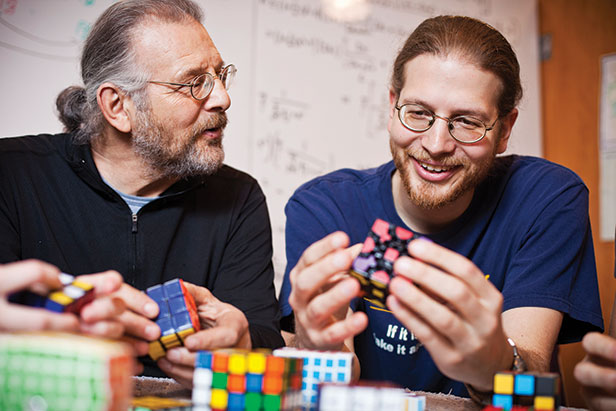
In 2010, an international team of researchers proved that no matter how scrambled a Rubik’s cube got, it would require no more than 20 moves to solve it. Their proof, however, relied on the equivalent of 35 years’ worth of number crunching on a good modern computer.
For cubes bigger than the standard Rubik’s cube, adequately canvassing starting positions may well be beyond the computational capacity of all the computers in the world. But in September, Erik Demaine (right), an associate professor of computer science and engineering, led a team including his father, CSAIL visiting professor Martin Demaine (left), that demonstrated the mathematical relationship between the number of squares in a cube and the number of moves in the shortest solution to its most scrambled state.
The standard way to solve a Rubik’s cube is to find a square that’s out of position and move it into place while leaving the rest of the cube as little changed as possible. That yields a worst-case solution whose number of moves is proportional to N2, where N is the number of squares per row. But the team saw that under some circumstances, a single sequence of twists could move multiple squares into place.
Describing those circumstances mathematically was no easy task. “In the first hour, we saw that it had to be at least N2/log N,” Erik Demaine says. “But then it was many months before we could prove that N2/log N was enough moves.”
Keep Reading
Most Popular
Large language models can do jaw-dropping things. But nobody knows exactly why.
And that's a problem. Figuring it out is one of the biggest scientific puzzles of our time and a crucial step towards controlling more powerful future models.
How scientists traced a mysterious covid case back to six toilets
When wastewater surveillance turns into a hunt for a single infected individual, the ethics get tricky.
The problem with plug-in hybrids? Their drivers.
Plug-in hybrids are often sold as a transition to EVs, but new data from Europe shows we’re still underestimating the emissions they produce.
Google DeepMind’s new generative model makes Super Mario–like games from scratch
Genie learns how to control games by watching hours and hours of video. It could help train next-gen robots too.
Stay connected
Get the latest updates from
MIT Technology Review
Discover special offers, top stories, upcoming events, and more.